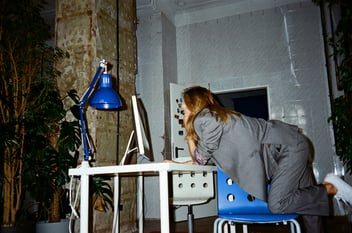Hi there! My name’s Emmi and I’m a recruiter at Vincit. I’m fascinated by people, their stories and their ambitions. As a curious person, I like talking to people, no matter what the topic is. I get excited about learning new things and I find people’s differences and personalities intriguing.
Now that that’s out of the way, welcome to this second part of Vincit’s blog series on recruitment. In this post we’re going to talk about chats, or interviews as they’re typically called in other places. We use the word chat since the meeting is far from a one-sided interview and more appropriately about getting to know somebody on a mutual and interactive basis.
Why a chat instead of a traditional interview?
The reason we prefer chats over interviews is simple: for many, just hearing the words job interview manages to raise stress levels and bring out a sweat. It reminds people of age-old horror scenarios: stepping into a room with a CV in hand, humbly clasping a hat to the chest with a shaking hand and being scrutinized by the potential employer. Luckily this type of interview doesn’t need to reflect current practices. A new job is always a jump into the unknown, which is why we believe that the first meeting should always make the person feel as relaxed and comfortable as possible. That’s also when you’re more likely to think clearly and come up with good answers.
As a recruiter, one of my most important tasks is to paint as realistic a picture of Vincit and working in the company as possible, as well as to respond to all questions openly and honestly. A job applicant is not merely a candidate, but a potential coworker. The first meeting is designed to make us all figure out whether we’re the right fit for each other.
How and where to chat?
“This was a meeting I’ll remember, I had a great time! Vincit’s recruiter and I went for a walk in the park and had an ice-cream.”
We give all our candidates four options regarding the place and manner of meeting for the first time. We’re firm believers in giving the candidate, our potential future colleague, the opportunity to make the choice. The candidate gets to state their preference when submitting their contact details. Our most popular options are a walk in the park or forest, a casual lunch, or meeting up at the office, which provides a glimpse into what the work facilities and future coworkers are like. It’s also possible to suggest something else entirely.
What do we talk about when we meet?
We always customize the chat according to the person we’re meeting. In other words, each chat is different, as are people. I find it particularly rewarding when I notice that the initial nervousness fades away and we suddenly laugh at something together. Being nervous is by no means forbidden, though! Come as you are and be you – that’s what we do, too.
But what do we ask our candidates and what is it we want to hear? Learning more about the person and our potential new colleague is always interesting. Usually we want to know who they are, what they’re looking for, what they can do, what they want from us, their future role and the rest of the Vincit gang, and what has made them consider changing jobs. We also like to hear why they’re interested in Vincit and, after the meeting, whether we met the expectations they had beforehand.
To help everyone prepare for the chat, we send our candidates some questions to answer before the meeting. We also invite the applicant to think of some tough questions to ask us. At the meeting, we encourage questions and putting us on the spot, because we are invested in giving the person all the answers they need. Asking some questions also helps the person judge whether Vincit’s the place where they really want to work. All questions are therefore more than welcome, the tougher the better. No holds barred.
What happens after the chat?
The recruitment process involves three or four stages. Since the process is always tailored according to the role, there may be some small changes along the way. Our goal is to complete the recruitment process as quickly as possible while taking each person’s schedules into consideration. On average, our recruitment process takes 2 to 3 weeks from start to finish.
This is how things progress:
- Chat with a Vincit recruiter at the chosen location.
- Possible preliminary assignment depending on the candidate’s competence level and position. Before the competence interview, we will email the applicant a preliminary assignment. The assignment can be done at home and at any time. The assignment usually needs to be submitted within 2 to 4 weeks, and we also take the person’s wishes into account.
- Competence interview. The purpose of this meeting is to get a better understanding of the person’s competences. The interview is divided into an approximately hour-long discussion and a competence test of the same length (for instance, in technical roles a technical test). We will send more information about this in advance to give the candidate time to prepare. The meeting features one or two technical experts and future colleagues.
- Almost there! Finally, we organize a meeting with the chief business officer. During the last meeting, the candidate gets to have a heart-to-heart with the cell’s head of business. The purpose of the final chat is to get to know each other and to provide additional information in order to reach a mutual decision. We are particularly interested in hearing what drives the candidate and how they are planning to create business value through their own work.
Please, give me feedback!
No matter what the outcome of the recruitment process is, we always welcome feedback with open arms. We know there’s always something we can improve on. At the end of the process, we send all our candidates a feedback survey, which allows them to mete out praise, point the finger or shake their entire fist at us. We’re also happy to give feedback to the applicant on skills they can develop in the future.
So, how do these chats sound to you?
This blog post is the second instalment in a blog series focusing on the work of our recruitment team. You can read the other entries by clicking below:



